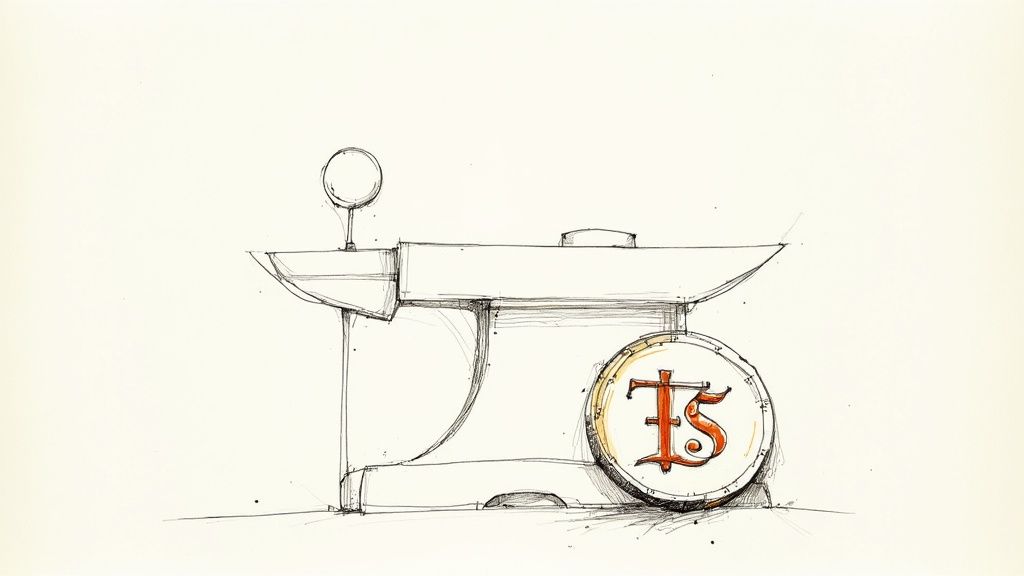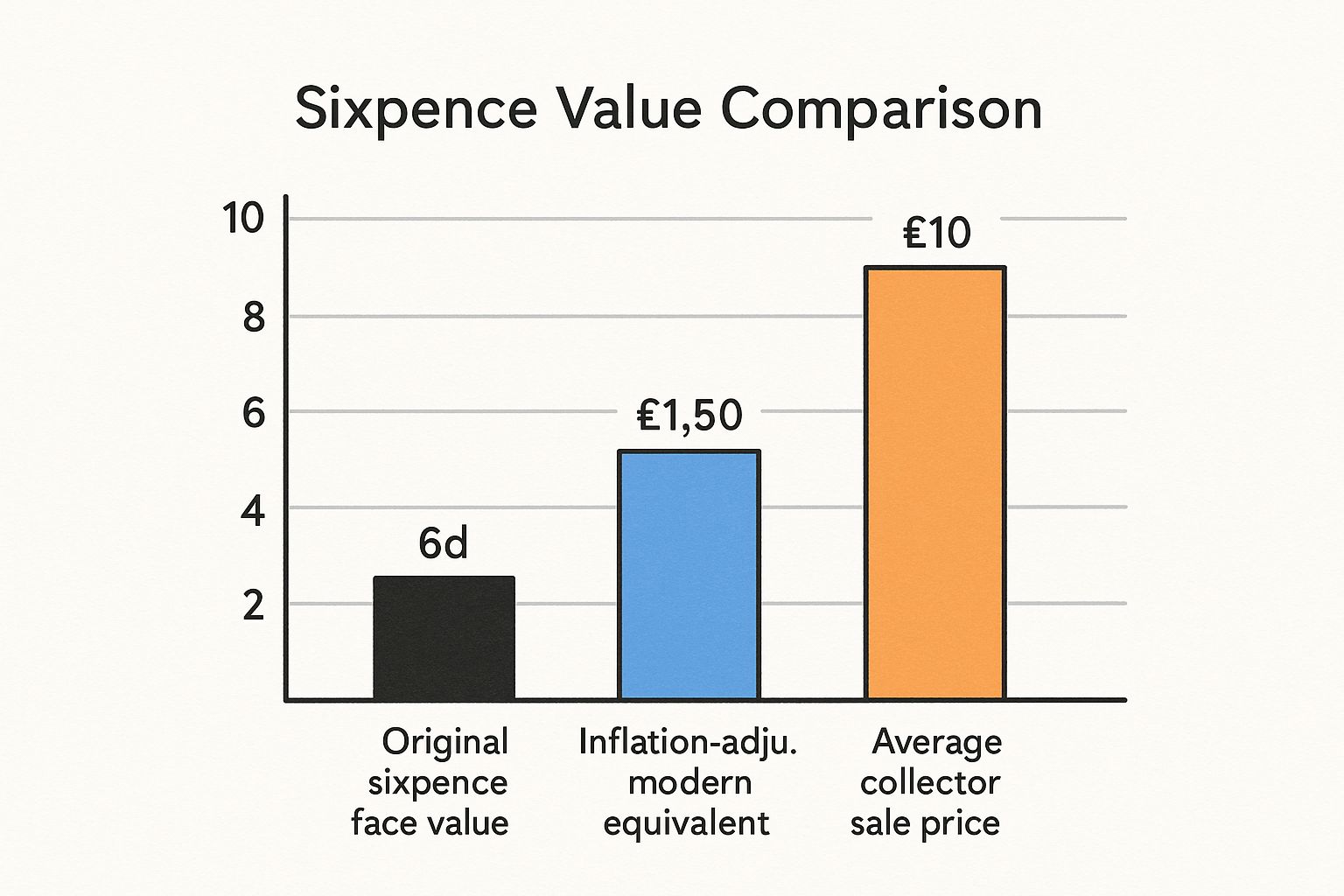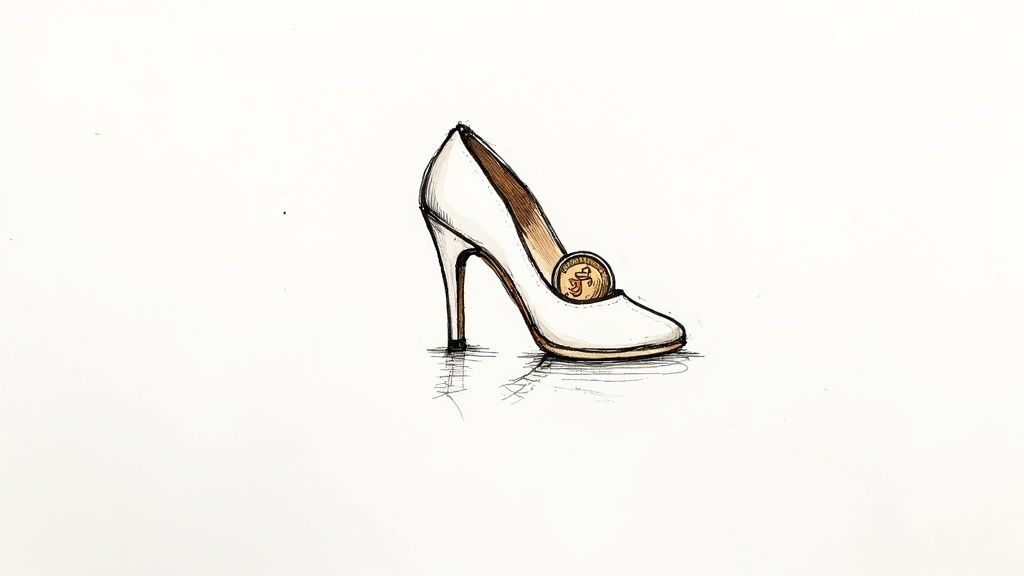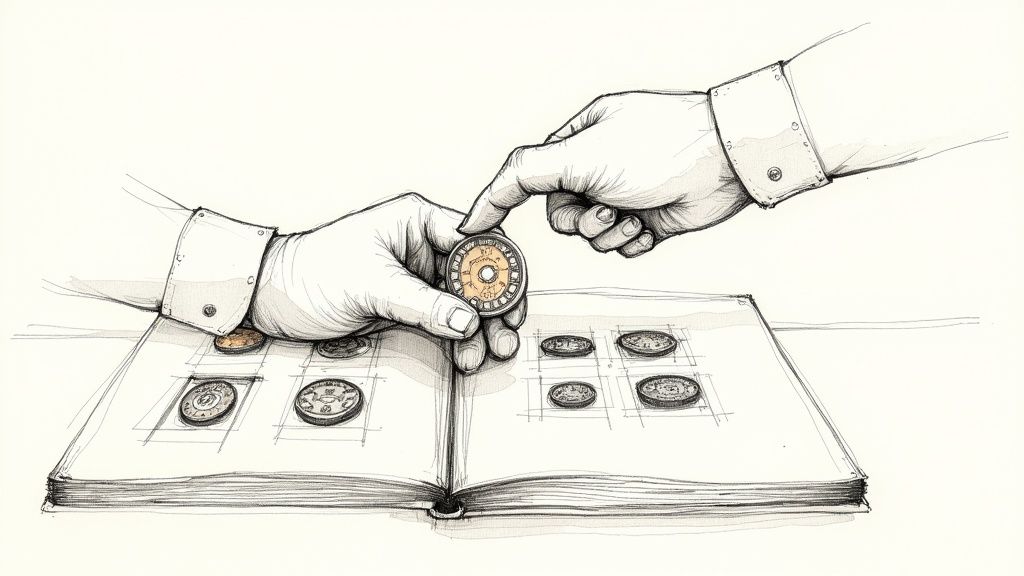So, you’ve stumbled upon an old sixpence and are wondering what it’s worth. The short answer? Its value can swing wildly from just a few pence to, in some cases, thousands of pounds.
This huge gap all comes down to its age, what it’s made of, how rare it is, and the condition it’s in today.
The Enduring Legacy of the Sixpence

The sixpence isn't just a forgotten piece of currency. It’s a tangible slice of British history that has fascinated collectors and romantics for centuries. Its journey from a Tudor-era silver coin to a cherished lucky charm tells a story of economic change, royal successions, and deep-rooted cultural traditions.
Getting to grips with this history is the first step in understanding why one sixpence might be worth little more than pocket change, while another could be a prized collector's item. This guide will break down exactly what makes a sixpence valuable. We’ll explore why a coin’s worth isn’t a single, fixed number but a story told through its unique characteristics.
From Tudor Silver to Modern Charm
The very first British sixpence was minted way back in 1551 under the reign of Edward VI. It was introduced to restore public confidence after the Great Debasement of the 1540s had left the country’s silver coinage in a sorry state.
Originally struck from sterling silver, it was worth exactly six old pence—half a shilling. It remained in circulation for over four centuries before finally being demonetised in 1980. You can find some fascinating details about the sixpence’s long history over on Copes Coins.
The true value of a sixpence is found by looking beyond its face value. It's a combination of its physical makeup, its historical context, and the simple laws of supply and demand in the collectors' market.
In this guide, we'll walk through every factor that plays a part in its modern valuation. We’re going to cover:
- Historical Evolution: Tracing its journey from a silver coin to one made of modern metals.
- Base Value Calculation: How to figure out the intrinsic worth of its metal content.
- Numismatic Premiums: Uncovering the key details that make collectors pay more.
- Cultural Significance: Exploring its beloved role as a lucky charm.
By the end, you’ll have a clear picture of what goes into valuing a sixpence and know exactly how to assess any you might have yourself.
A Journey Through Four Centuries of Coinage
To really get a feel for what a sixpence is worth, you need to know its story. This isn't just about dates; it's a tale of shifting economies and changing monarchs, all of which directly impacts a coin's value today. The journey kicked off way back in 1551, when the sixpence was introduced to bring some much-needed trust back into British currency.
For hundreds of years, the sixpence was a part of everyday life, reliably struck from sterling silver (92.5% pure). This high silver content meant the coin had a built-in, intrinsic value—it was worth the metal it was made from. That's the first, most crucial piece of the puzzle when valuing one.
The Great Silver Divide
The biggest plot twist in the sixpence's long history came just after the Second World War. Britain had war debts to pay to the United States, and the government took a drastic step. In 1947, they stopped making the sixpence from silver and switched to cupronickel, a simple alloy of copper and nickel.
This one decision instantly split the world of sixpences in two, creating a clear line for any collector or valuer:
- Pre-1947 Sixpences: These coins are the real deal—they contain silver. This gives them a base "melt value" tied to the current market price of silver. A common, worn-out sixpence from before 1947 is always worth at least its weight in silver.
- Post-1947 Sixpences: These are made from common metals, so they have no precious metal value. Their worth is almost entirely based on their condition and how rare they are as a collector's item.
This isn't just the story of one coin, of course. To see the bigger picture, you can explore a brief history of British coins and get more context on these monumental changes.
Decimalisation and the Final Chapter
The sixpence soldiered on after the switch to cupronickel and remained a well-loved coin, but another seismic shift was coming. When Britain went decimal in 1971, most of the old coins were pulled from circulation. The sixpence, however, got a temporary stay of execution.
Thanks to a massive wave of public affection, the coin was allowed to keep circulating with a new value of 2.5 new pence. It was one of the very few pre-decimal coins to survive the changeover, which really speaks to how much people treasured it.
But its extended life wasn't to last. The "tanner," as it was affectionately known, was finally demonetised and officially withdrawn in June 1980. This brought its incredible 429-year run as legal tender to a close, cementing its place as a piece of history. Knowing this timeline is absolutely key, as it tells you whether you're holding a piece of silver heritage or a more modern keepsake.
Calculating Your Sixpence's Base Value
Every valuation has to start somewhere. For a sixpence, that starting point is its melt value—the raw, intrinsic worth of the precious metal inside it. Think of it like valuing a house; before you admire the period features or the lovely garden, you first need to know the basic value of the bricks and mortar.
The first thing you need to check is the date stamped on your coin. As we've seen, the year 1947 is the great dividing line. Any sixpence minted before this date contains silver, which gives it an immediate, tangible value based on current silver prices. Those minted from 1947 onwards are made from cupronickel, a mix of copper and nickel, and have no precious metal value at all.
Spotting a Silver Sixpence
Thankfully, working out if your sixpence is silver is dead simple. Just look at the date. The purity of the silver, however, did change over time, and this directly affects the coin's melt value.
Here's the breakdown you need to keep in mind:
- 1551–1919: For most of its life, the sixpence was struck from sterling silver, which is 92.5% pure silver.
- 1920–1946: The economic fallout from the First World War forced a change. Sixpences from this era contain only 50% silver.

The image above really drives home how a sixpence's collector value can dwarf its original face value or even what it would be worth today with inflation. It shows that while inflation provides some context, the coin's true potential is unlocked in the numismatic market.
To calculate the melt value yourself, you'll need three things: the coin's weight (a standard silver sixpence weighs about 2.83 grams), its silver purity (either 92.5% or 50%), and the current spot price of silver. This calculation gives you the absolute floor price for your coin. If you're curious to learn more about the metals used in old currency, our guide on what coins are made of is a great place to start.
Sixpence Silver Content and Melt Value by Era
To make this clearer, here’s a table showing how the silver content shifted over the years and what that means for the coin's basic value. We've based the melt value on a sample silver price to give you a practical idea.
| Reign/Period | Years | Silver Purity | Approximate Melt Value (at £0.75/gram of silver) |
|---|---|---|---|
| Pre-Debasement | 1551–1919 | 92.5% (Sterling) | Approximately £1.97 |
| Post-Debasement | 1920–1946 | 50% | Approximately £1.06 |
| Post-Silver | 1947–1967 | 0% (Cupronickel) | £0.00 |
Of course, the silver market fluctuates daily, so these values are just an estimate. However, they clearly show the two distinct tiers of silver sixpences you'll encounter.
From Melt Value to Market Value
It's really important to realise that melt value is just the beginning of the story. It’s the absolute minimum a silver sixpence is worth on any given day. In reality, almost nobody would ever melt down a historic coin, because its numismatic value—what a collector will actually pay for it—is often much, much higher.
A common, worn-down George V sixpence from the 1920s might only be worth a couple of quid based on its silver content. In stark contrast, a rare sixpence from the reign of Charles I could be worth hundreds or even thousands of pounds, despite having a similar melt value.
This difference is what we call the numismatic premium. It’s all the extra value added by factors like rarity, condition, historical significance, and simple collector demand.
The melt value gives you a safety net, but the real excitement in valuing a sixpence comes from exploring these other, more fascinating factors. That's exactly what we'll dive into next.
Understanding the Numismatic Premium

So, why would one sixpence be worth its weight in silver while another fetches hundreds of pounds at auction? The answer, in a word, is numismatics.
This is where a coin’s story and rarity come into play, creating a numismatic premium – the extra value collectors are willing to pay far beyond its simple metal content.
Think of it like a first-edition book versus a modern paperback. Both tell the same story, but the history, scarcity, and unique character of the original make it infinitely more valuable to a collector. This very same principle transforms a humble sixpence from a piece of currency into a sought-after historical artefact.
This premium isn't built on a single factor. Instead, it’s a blend of several key characteristics that collectors actively hunt for. Getting to grips with these is the first step in spotting a potentially valuable coin.
Key Drivers of Numismatic Value
The difference between a common coin and a rare treasure often boils down to just a few crucial details. When assessing a sixpence, seasoned numismatists focus on four critical areas that, together, determine its collector value.
- Mint Year and Reign: Coins from certain years had tiny mintage numbers, making them rare from the get-go. Similarly, sixpences from short-reigning monarchs are often far more desirable.
- Minting Errors: Mistakes made during production – things like an incorrect design or a double strike – can create exceptionally rare and valuable variations. These 'mistake' coins are often prized possessions.
- Historical Significance: Was the coin minted during a pivotal moment in history, like a major war or a change in the monarchy? This context adds a layer of appeal that collectors love.
- Condition (Grade): This is perhaps the most important factor of all. A coin's state of preservation can multiply its value dramatically.
A well-preserved, uncirculated coin can be worth 10 to 100 times more than the exact same coin that is heavily worn from its time in circulation. The sharpness of the details makes all the difference.
The Critical Role of Coin Condition
The condition, or grade, of a coin is simply a professional assessment of its wear and tear. It’s a language all collectors speak. A coin that looks almost new, with crisp details and its original mint lustre, will always be graded much higher than one that is scratched, worn flat, and faded.
For serious collectors, higher grades are everything.
Grading can seem a bit complex at first, with its specific terms ranging from "Poor" all the way up to "Uncirculated" and even "Proof". If you want to get a handle on it, our detailed coin grading guide is perfect for beginners and experts. It will walk you through how to inspect your sixpence and estimate its condition accurately.
This is a fundamental skill, as the grade directly dictates how much a collector would be willing to pay.
How to Spot a Rare Sixpence in the Wild
Alright, you've got the basics down. Now for the fun part: turning that knowledge into a real-life treasure hunt. For over four hundred years, billions of sixpences were churned out, but only a tiny fraction are the ones that make collectors' hearts skip a beat. Finding them is all about knowing what to look for—specific dates, tiny mint marks, and the stories behind the metal.
Think of it like this: if a million copies of a book are printed, they aren't especially rare. But if only a few thousand were made in a particular year, you've suddenly got something special. The same logic applies here. The trick is to hunt for the exceptions.
The A-Listers of the Sixpence World
Some sixpences are true legends in the coin-collecting community. These are the coins that consistently spark bidding wars at auctions, usually because they have an incredible backstory or are ridiculously hard to find. Knowing which ones to look for can turn a rummage through an old tin of coins into a genuinely exciting moment.
Here are a few of the big names to keep an eye out for:
- Tudor and Stuart Survivors (1551-1714): Frankly, any sixpence you find from the time of Edward VI, Elizabeth I, or Charles I is a fantastic find. Their sheer age and historical weight make them desirable, though their value is massively influenced by how well they've survived the centuries.
- Victorian "Gothic" Beauties (1887): The 1887 sixpence featuring the "Gothic" style portrait of Queen Victoria is a firm favourite. Look for the version with the "withdrawn" shield design on the back—it's the one collectors really want.
- The Mythical 1952 Sixpence: This is it. The holy grail for any serious sixpence enthusiast. Its story is a perfect storm of history, scarcity, and chance.
The 1952 sixpence is exceptionally rare because it was never meant for circulation in the UK. A very small batch was minted just before King George VI died, intended for use in places like Jamaica. Its unique history and the fact that almost none have survived make it the rarest sixpence of them all, with a price tag to match. You can dive deeper into the history of the sixpence to understand what gives certain dates their star power.
Beyond the Headline-Grabbing Dates
While it's thrilling to dream of finding a 1952 coin, there's plenty of value hidden in less obvious places. Don't overlook coins from the early 20th century, especially from the reign of George V. Some years had surprisingly low production runs, and finding one in pristine condition is always a win.
Then there are the happy accidents: minting errors. A coin struck slightly off-centre, one showing a crack from a worn-out die, or any other quirk from the production line creates a true one-off. These "error coins" can be incredibly valuable to specialists who prize their uniqueness.
Always give your coins a close look. What might seem like a bit of damage at first glance could actually be a rare and valuable minting error that transforms an ordinary coin into a collector's prize.
To give you a head start, I've put together a quick guide to some of the most sought-after sixpences. Think of it as a spotter's guide for your next coin hunt.
Examples of High-Value Sixpence Coins
This table is a quick-reference guide to some of the most sought-after sixpence coins, highlighting their key features and estimated value range based on condition.
| Year/Reign | Key Feature | Reason for Rarity | Estimated Value Range (Fine to Uncirculated) |
|---|---|---|---|
| 1567 (Elizabeth I) | Small, hammered coin with the Queen's bust | Extreme age and historical significance from the Tudor period. Survival rates are naturally very low. | £100 - £2,500+ |
| 1787 (George III) | "No Hearts" in the Hanoverian shield design | A well-known variety where the hearts in the shield are absent. Highly popular with specialist collectors. | £50 - £800 |
| 1887 (Victoria) | "Withdrawn" Jubilee shield reverse | The design was quickly replaced due to public dislike, resulting in a very short minting period. | £40 - £600 |
| 1926 (George V) | "Modified Effigy" bust | A subtle redesign of the King's portrait was used for part of the year, creating a scarce variant. | £20 - £300 |
| 1952 (George VI) | The only coin from this year | Minted for colonial use just before the King's death; almost none entered circulation or survived. | £50,000 - £100,000+ |
Remember, this is just a starting point. The world of rare coins is full of surprises, and the condition of a coin—its grade—plays a massive role in its final value. Happy hunting
More Than Money: The Sixpence as a Lucky Charm

Forget numismatic charts and silver prices for a moment. The sixpence holds a powerful cultural value that you simply can't measure in pounds and pence. For generations, this small coin has been a cherished symbol of good fortune, woven deep into the fabric of British traditions and personal memories.
This sentimental worth adds a completely different, fascinating layer to the coin's value. It stopped being just money a long time ago and became a beloved keepsake, connecting us to a rich history of folklore and family heritage. Its role in these traditions is arguably just as important as its rarity or condition when we think about its true worth.
A Bride's Best Friend
The most famous tradition, of course, is the one immortalised in that well-known bridal rhyme. The Victorian-era verse lays out exactly what a bride should carry to ensure a happy marriage.
Something old, something new,
Something borrowed, something blue,
And a silver sixpence in her shoe.
Tucking a sixpence into the bride’s left shoe was a powerful wish for prosperity and a happy, wealthy life with her new husband. This simple act turned an everyday coin into a potent good luck charm. It’s a tradition that many still cherish today, with some families passing down the very same sixpence through generations, adding a beautiful layer of personal history to its symbolic power.
Festive Fortunes and Childhood Rhymes
The sixpence’s role as a lucky token goes far beyond weddings. For centuries, it was a common practice to stir a sixpence into the Christmas pudding mixture. Whoever was lucky enough to find the coin in their serving on Christmas Day was said to be in for a year of wealth and good fortune.
This tradition really cemented the sixpence in the heart of family celebrations. You’ll also find its cultural footprint in familiar nursery rhymes like "Sing a Song of Sixpence," connecting the coin to the earliest memories of childhood for millions. This enduring presence in our collective memory ensures that the value of a sixpence will always be more than its price tag; it's a little piece of history that keeps on bringing luck.
Your Sixpence Questions Answered
Diving into the world of old coins can spark a lot of curiosity. Let's tackle some of the most common questions that come up when people discover a sixpence, giving you the straightforward answers you need.
How Can I Tell If My Sixpence Is Silver?
This one's surprisingly simple – it all comes down to the date.
Take a close look at your coin. If it was minted before 1947, you're holding a silver coin. The silver content does vary, though:
- Coins dated 1920-1946 are 50% silver.
- Those minted before 1920 are made of 92.5% sterling silver.
Any sixpence dated 1947 or later is made from a copper-nickel alloy (cupronickel), so its value lies in its condition and collectability, not its metal content.
What’s the Best Way to Sell a Valuable Sixpence?
If you suspect you've got a real gem on your hands—perhaps a particularly old or beautifully preserved coin—a reputable coin auction house is your best port of call. They have the expertise and the right audience of serious collectors ready to pay a premium.
For the more common silver sixpences or mid-range collectable coins, online marketplaces like eBay or dedicated coin forums are excellent options. These platforms open your coin up to a huge pool of interested buyers directly.
A golden rule for any coin collector is to never clean old coins. It might seem tempting, but cleaning can leave tiny scratches and strip away the patina—the natural layer of toning that develops over decades. This can devastate a coin's numismatic value, often reducing a valuable collectable to being worth only its weight in metal.
Are Sixpence Coins Still Legal Tender?
No, the sixpence is no longer legal tender in the UK.
For a while after decimalisation in 1971, it was allowed to circulate with a value of 2.5 new pence. However, it was officially withdrawn from circulation and demonetised on 30 June 1980. Today, its value is purely based on its silver content or its appeal to collectors.
Whether you're hoping to identify a hidden treasure or add a piece of history to your collection, Cavalier Coins Ltd offers a huge range of coins for every kind of enthusiast. Explore our curated selections and weekly auctions to find your next great piece. Visit us at https://www.cavaliercoins.com.

